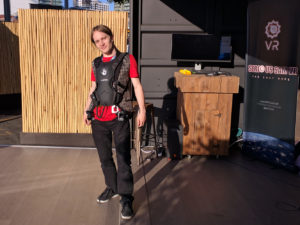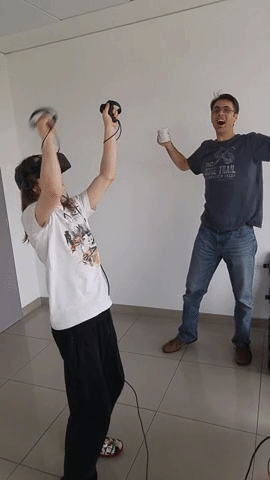Project lead Mario Kotlar shares his thoughts on The Talos Principle VR launch – and you can’t stop him!

Mario – a VR aficionado always ready to try out new accessories and technologies.
We’ve sat down with Mario Kotlar, Project Lead on The Talos Principle VR, a VR aficionado that has preordered every headset imaginable (except for one) and perhaps the main culprit for Croteam’s involvement in VR.
He’s been a vocal advocate of the VR tech on Reddit and forums but spends his days in the office silently working long hours just to create what he feels the VR space needs the most – great games. Although The Talos Principle VR is now available on Steam, Mario doesn’t look any less busy. Still, we felt there are some questions that only he could answer.
Mario, how do you feel about The Talos Principle VR now that the game is finally out?
I often see people saying how Talos is just the perfect game for VR. That it must have been designed with VR in mind, and such. One would think adapting it for VR would be a breeze. I wish I could show you how long our list of bugs and necessary new features was. And this was after the engine already had fully functional VR support from a technical standpoint, which was worked on for over two years now, mostly throughout the development of Serious Sam The Last Hope.
Flat games can feature all kinds of limitations in order to shape the gameplay, and nobody will bat an eyelash. Can’t throw jammer through a window-sized hole in the wall? Oh well, there just isn’t a button that does it so you move on. But in VR, if you can’t do something that would otherwise be possible in real life, suddenly it’s a little bit weird! But when the alternative is allowing something that would break the entire game, best you can do is try to make it subtle. So we had to go through a lot of extra effort as this kind of game-breaking situations were omnipresent within the game. For pushing or grabbing jammer through a hole in the wall, we detect when a player is attempting to do it, then teleport him a little bit back, so that it appears that such an action just happens to be somewhat out of reach. It’s the same teleport-pushback that we use to prevent player from clipping through walls, so it’s the closest VR can get to simulating a solid surface where there is none. Since this is something people are relatively used to by now, relying on the same mechanic in order to simulate something supposedly being out of reach isn’t that far of a stretch. It still requires some suspension of disbelief, but ultimately it has to be a compromise or we’d end up having to design a whole new game with a different set of mechanics and puzzles.
But that was just the tip of the iceberg. First time I walked up to a platform mechanic in VR, and picked it up, I just went “oh…”. We really wanted to try and keep mechanics as immersive as possible, to achieve as much presence as we can, but platform just flew straight in the face of that. For those unfamiliar, in Talos player is supposed to turn on the recorder, pick up the platform and then hold it above his head, go places, then turn off the recorder to start the playback. At which point his recorded ghost appears, which enables the player to jump on top of himself. In flat Talos, merely picking up the platform would have the player hold it flat above himself automatically, there was nothing else player could do with it, it was the default and only animation, and this itself is a conscious design decision. It’s a very important hint which enables player to solve the first puzzle that features this new mechanic, by figuring out how to use it. It would be far from impossible to create a VR tutorial that teaches this step-by-step, but once you try actually play-pretending this in VR, you quickly realise that it isn’t going to work. Firstly, holding both hands up leaves you with no artificial locomotion, and even if you only held one hand up, it’s not only hard and exhausting to keep level, it’s our biological arms that are the problem, as they just hate being held up for longer than few dozen seconds. If we went and did this for the sake of presence and immersion, most people would go play flat Talos instead within 10 seconds of trying to solve a recorder-platform puzzle.
One of the big issues was artificial involuntary locomotion. Talos, after all, not only features electric mines that can bump you around and underlying physics system that could cause literally anything to push you in any direction, but also plenty of giant fans, some of which are capable of blowing you away halfway across the map at speeds and accelerations jetliners wouldn’t be ashamed of. Figuring out the solution to fans wasn’t too difficult, as third-person camera looked like the only viable approach from a mile away. But actually implementing it, meant going through all the fans in the game and manually carefully defining camera locations in order to make potentially unexpected camera jumps less disorienting.

Mario testing new features, with support from his very serious colleagues.
But what about jumping down from the tower? Can’t define custom camera locations for that. So we approached this and all other such situations in a similar way. We dynamically place a virtual camera at your exact eye coordinates, the moment we detect involuntary artificial movement, and then immediately switch to it, whether the movement was caused by gravity or something bumping into you. We then make the player’s full body visible and make ghost controllers appear instead of robot hands, which serve as cues for not actually being where you are. Ghost controllers also allow some level of control over the 3rd person character, because after all, involuntary moving a little never stopped you from being able to control yourself in the flat game.
However, there was one involuntarily movement not even the third person camera could handle. The type of movement where you actually need to have precise input, in order to interact with other puzzle elements in real-time, while involuntary moving. You might have guessed it – riding on cubes that are riding on mines. There were no elegant solutions to be found here anymore, as we definitely needed 1st person control, and we definitely needed to avoid motion sickness from mines moving, changing direction, accelerating and decelerating. So we did the only remaining thing that came to mind, auto-micro-teleports. And it actually worked! Sure you will spend a fraction of time floating midair, your floor will be sliding below you, and you’ll be teleported multiple times per second, but it works! Involuntary, first person, motion-sickness-free motion, in VR. This method we found works for low to medium movement speeds.
At first, we had the vision of player physically grabbing items like rods and jammers in order to pick them up, and then let go to place them anywhere in the world, to just have them physically fall down whenever and work. Immersive right? Unfortunately, it turns the gameplay from fun into a horrible chore. It’s great the first few times, but when walking up to jammer for the 500th time, you just want to murder the developer who made you walk that extra step, who forced you to precisely touch the object with your hand, rather than just quickly reach out in the general direction. Oh, and did I mention that merely trying to implement this broke more than a dozen puzzles that flat out (heh) relied on being able to pick objects up from 3 meters distance. What? You never noticed you were able to interact with everything from 3 meters away in flat Talos? 😉 My point exactly. For the sake of immersion and presence, we actually did lower the range by half a meter. If we left it at 3 meters, we might as well have given you a lightsaber.
Funnily enough, having third-person camera handle fan-related motion sickness, did break one of the puzzles in Gehenna. I won’t tell you which one, as that could be a spoiler for both flat Talos, and VR Talos played with 3rd person camera option disabled. Our goal was to adapt the game, without changing the puzzles, if at all possible, so that people who chose to play it in VR, get the same puzzle solving gameplay experience that the flat Ttalos players loved so much. We’re happy to say we more than 99% achieved this, and in this 1% situation, we managed to preserve the original puzzle for the most part. So now there is one puzzle, which will automatically reconfigure itself to be ever so slightly different when your motion sickness options feature 3rd person camera fallback. I’ll leave it to you to figure out which puzzle that is.
All right. Next question?
Nah. I think we’re good here.
Sign In